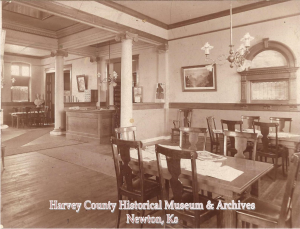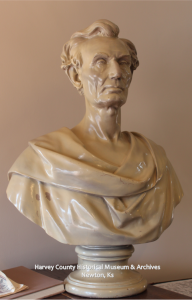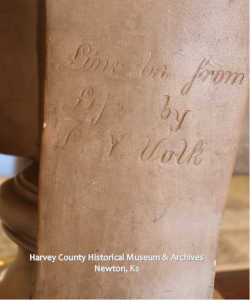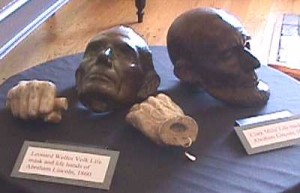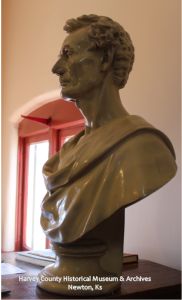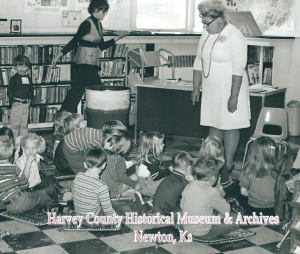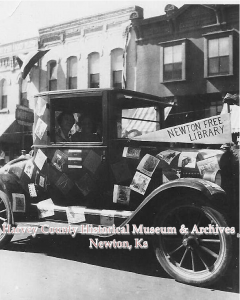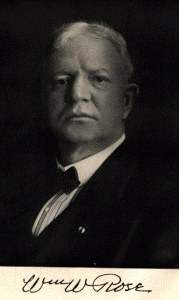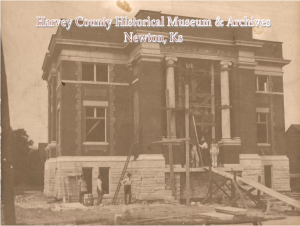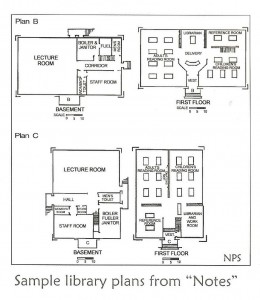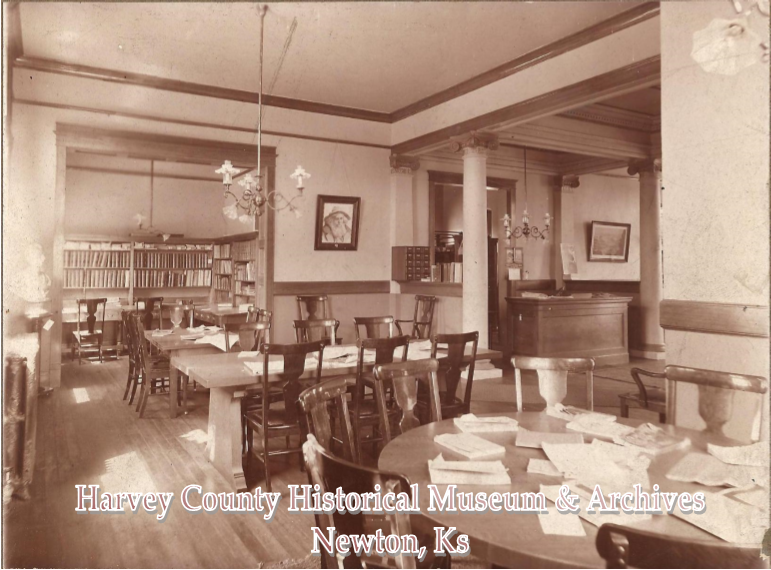by Kristine Schmucker, HCHM Curator
In addition to the Murphy portrait, one other object remains as part of the museum from when the building served as the Newton Free Library. A sculpture, entitled “Lincoln from Life” by Volk is a fixture in the in the Archives. The sculpture, at one time, was displayed in the southwest corner of the main floor reading room (see photo below).
The Lincoln bust was a gift from W.I. Plumb. Born in Ohio in 1848, Plumb engaged in business pursuits in several states. He came to Newton, Ks, in 1887 and established the China Emporium at 504 Main. The business was noted as “the only store of its kind in Newton and had long been a landmark in the business district and is a very prosperous enterprise.” He served for a number of years on the Newton School Board and was a deacon in the Congregational Church. He was married to Euphemia Carr in 1871 and the couple had 10 children with 5 living to adulthood.
Shortly after the Newton Free Library opened, Plumb donated the sculpture.
“On motion the Library Board accepted the fine bust of Lincoln given by Mr. W.I. Plumb, and directed that a vote of thanks be extended to him.”
The plaster bust of Lincoln is known as the “draped” or “Romanesque” rendering.
Leonard Volk, artist
Leonard Wells Volk was a sculpture born in New York state in 1828. From 1855 to 1857, he studied his craft abroad. He settled in Chicago when he returned. Among his work are a life-sized statue of Stephen Douglass in marble. He also executed several busts and statues of prominent men.
Creating the mask
Volk made the first life mask of Lincoln in 1860, several months before Lincoln won the presidential election. Making the plaster cast was “anything by agreeable” according to Lincoln.
Volk described creating the mask at his studio in the Portland Block in Chicago.
“My studio was in the fifth story, and there were no elevators in those days, and I soon learned to distinguish Lincoln’s steps on the stairs, and am sure he frequently came up two, if not three steps at a stride.”
Lincoln was there promptly each morning and never failed to be on time. On one occasion Lincoln observed:
“I have never sat before to sculpture or painter — only for daguerreotypes and photographs. What shall I do?”
Volk first took measurements of Lincoln’s head and shoulders and made a plaster cast of the face.
“It was about an hour before the mold was ready to be removed, and being all in one piece, with both ears perfectly taken, it clung pretty hard, and the cheek-bones were higher than the jaws at the lobe of the ear. He bent his head low and took hold of the mold, and gradually worked it off without breaking or injury; it hurt a little as a few hairs of the tender temples pulled out with the plaster and made his eyes water.”
Shortly after Lincoln received the nomination for president, Volk made a cast of Lincoln’s hands (see above photo). The cast of Lincoln’t right hand appears noticeably larger than the left. Volk recalled that this was “on account of excessive hand-shaking the evening before.”
The second mask in the photo is of the Clark Mill life mask made in February 1865. A comparison reveals a much older looking Lincoln in addition to the beard.
The various busts and statues Volk produced, including HCHM’s, were based on the life mask made in his studio in 1860. Later artists also relied on the mask by Volk as a “most reliable document of the Lincoln face . . . it is the actual form.“
Sources:
- A Standard History of Kansas and Kansans: William I. Plumb, 1918.
- Fielding, Mantele. Dictionary of American Painters, Sculptors and Engravers, 1926.
- www.abrahamlincolnonline.org/lincoln/resource/masks.htm
- Lincoln Life Masks at the National Portrait Gallery


